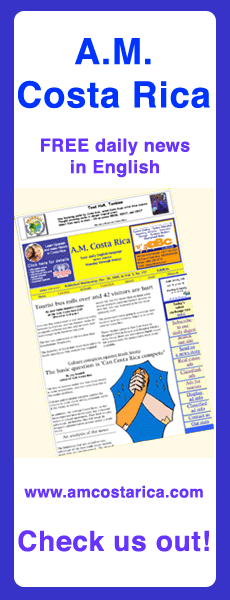Costa Rica Expertise LLC
Post details: Smile! All of Costa Rica Is On Candid Camera
02/07/05
Smile! All of Costa Rica Is On Candid Camera
By Garland M. Baker
Special to A.M. Costa Rica
Google has put Costa Rica on the map. Literally.
Google acquired Keyhole Corp. last October 2004 adding the firm’s service to its growing list of satellite imaging offerings.
Founded in 2001, Keyhole is the 3D digital Earth pioneer — the only company to deliver a 3D digital model of the entire Earth via the Internet.
Costa Rica is now included in medium resolution. At this 80-meter to 200-meter view one can’t see what Ticos are having for breakfast, but one can see the craters of most of the country’s volcanoes in great detail along with other sights of the nation.
Presently, a number of Earth observation systems continuously monitor the surface. The U.S. National Aeronautics and Space Administration along with the U.S. Geological Survey and other organization have donated maps to countries of Central America, allowing them to develop strategies for protecting the environment and for urban planning. However, the availability of the maps has been limited to people in academics and government.
Costa Rica is now available to the general public, and it is the only country in Central America that is, thanks to Google. Virtual tourists can actually tour almost the entire country using Keyhole. Real estate developers can do site analysis and prepare movies for prospective clients along with high-resolution printouts. The uses of digital cartography are endless.
This technology is just getting better by the year. New satellites can photograph the earth at an incredible one-foot spatial resolution.
What is spatial resolution?
Spatial resolution is the distance along the ground between samples in a satellite
photograph. If a satellite image has a spatial resolution of 30 meters this means that one pixel in the image represents a square of 30 by 30 meters on the Earth’s surface. In an image of this resolution, one cannot see small buildings, but can definitely see a football field or plantations. At one-foot resolution, one can see someone in a swimming pool.
Satellites are contributing to the growing field of GIS.
What is GIS?
Maps have always been a powerful way to represent information. Geographic information systems (GIS) combines the power of maps, satellite images, and aerial photographs with databases that store information behind the maps and images to study natural hazards and disasters, population growth, water resources, and minerals deposits, to name only a few topics on a very long list.
Want to take at trip to Costa Rica and don’t have enough for the airfare? Use your Internet browser and download the free trial of Keyhole.
Travel in the comfort of your home.
If you’re planning a trip for pleasure or to evaluate a piece of property, you can check out the area you are interested in before you come.
Garland M. Baker has been a resident of Costa Rica since 1972 and is now a naturalized citizen. He provides multidisciplinary professional services to the international community. Reach him at [email protected] Baker has undertaken the research leading to these series of articles in conjunction with A.M. Costa Rica. Copyright 2005, use without permission prohibited.
Obtain a Complimentary Reprint of this article by clicking here: FREE REPRINT
Costa Rica Expertise LLC
This web site contains articles written by Garland M. Baker and Lic. Allan Garro for the A.M. Costa Rica. These articles contain important information that everyone doing business—personal and corporate—in Costa Rica ought to know. Reach them at [email protected]
A Complimentary Reprint is available at the end of each article.

Search
Categories
| Mon | Tue | Wed | Thu | Fri | Sat | Sun |
|---|---|---|---|---|---|---|
| << < | > >> | |||||
| 1 | 2 | 3 | 4 | 5 | 6 | |
| 7 | 8 | 9 | 10 | 11 | 12 | 13 |
| 14 | 15 | 16 | 17 | 18 | 19 | 20 |
| 21 | 22 | 23 | 24 | 25 | 26 | 27 |
| 28 | 29 | 30 | ||||
Links
Government Web Sites- Caja Costarricense de Seguro Social
- Direccion General Migracion Costa Rica
- Gobierno de Costa Rica
- ICE
- Instituto Costarricense de Turismo
- Instituto Nacional de Seguros
- La Gaceta - Diario Oficial
- La Procuraduría General de la República
- Ministerio de Justicia
- Ministerio de Trabajo y Seguridad Social
- Poder Judicial
- Radiografica Costarricense S.A.
- Registro Nacional
- Registro Nacional Sistema de Consultas
- Colegio de Abogados
- Colegio de Arquitectos
- Colegio de Contadores Privados
- Colegio de Contadores Publicos
- A.M. Costa Rica
- All CR Expertise Articles
- Babelfish Web Site Translator
- Carfax.com
- Currently Suspended Lawyers
- Google Earth - formerly Keyhole - 3D satellite imaging
- U.S. Department of State
- U.S. Visa Denials Page
- U.S. Visa Home Page
- United States Embassy in Costa Rica
- US Embassy Death Assistance Page
Syndicate this site 
What is RSS?

powered by
![]()


